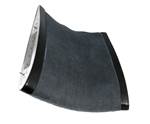Shape shifters: The molecular basics
The key to SMP shape change is the fact that an SMP can exhibit a radical transformation from a rigid polymer to a malleable elastomer and back again.
The key to SMP shape change is the fact that an SMP can exhibit a radical transformation from a rigid polymer to a malleable elastomer and back again. SMP researcher Thorsten Pretsch of BAM Federal Institute for Materials Research and Testing (Berlin, Germany), explains that, on the molecular level, SMPs are “polymer networks with integrated, stimuli-sensitive switches. Suitable polymer network architectures consist of chain segments and netpoints. Since the netpoints crosslink the chain segments, they determine the permanent shape of the polymer. The crosslinks can be either of chemical nature (covalent bonds) or physical nature (intermolecular interactions like crystals and chain entanglements); they prevent flow of the molecular chains under deformation.”
A thermally activated SMP shifts between its rigid and elastic state at its glass transition temperature (Tg). According to Cornerstone Research Group (CRG, Dayton, Ohio), the SMP can be formulated with a Tg that matches an application need. By triggering polymer molecule chain segments that have a specific Tg, the material can be deformed, and this deformed shape is maintained when the material is cooled. Once the material is heated above its Tg again, its “memory” kicks in and it returns to its original shape.
SMPs can be either thermoset or thermoplastic. “In general, thermoset SMPs have higher stiffness and lower strain capability than thermoplastic SMPs, which are easy to reshape, since they have no covalent bonds between chains,” says Pretsch.
Related Content
-
The potential for thermoplastic composite nacelles
Collins Aerospace draws on global team, decades of experience to demonstrate large, curved AFP and welded structures for the next generation of aircraft.
-
A new era for ceramic matrix composites
CMC is expanding, with new fiber production in Europe, faster processes and higher temperature materials enabling applications for industry, hypersonics and New Space.
-
Combining multifunctional thermoplastic composites, additive manufacturing for next-gen airframe structures
The DOMMINIO project combines AFP with 3D printed gyroid cores, embedded SHM sensors and smart materials for induction-driven disassembly of parts at end of life.












